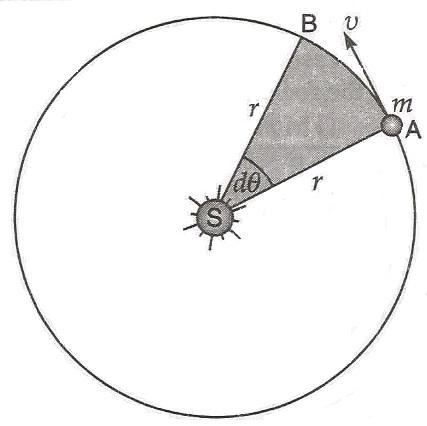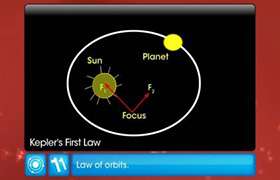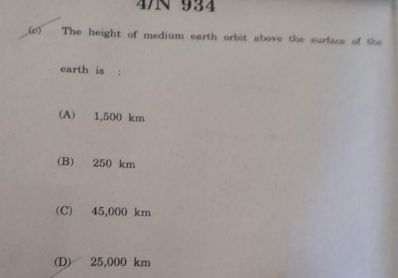CBSE Class 11-science Answered
derive keplers 2nd and 3rd laws?
Asked by Sanmit Ratnaparkhi | 12 Sep, 2015, 02:52: AM
Kepler's second law:
Consider that a planet of mass 'm' revolving around the Sun of mass 'M' in a circular orbit of radius 'r'. Let 'v' be its orbital velocity. Suppose that at any isntant the planet is at point A in its orbit and after an in small time dt, it reaches point B. As such, the circular path of the planet between points A and B may be considered as straight.

If dA is small area swept by the line joining the planet to the Sun in time dt, then
dA=area of ΔABS=

or dA= .... (1)
.... (1)
 .... (1)
.... (1)If dθ is the angular displacement of the planet in time dt i.e., when it moves from point A to B, then AB=r dθ.
Substituting AB with rdθ and AS with 'r' in equation(1), we get,

Dividing the above equation by dt, we get,

where ω= is the angular speed of the planet in its orbit and
is the angular speed of the planet in its orbit and  is the areal velocity of the planet.
is the areal velocity of the planet.
 is the angular speed of the planet in its orbit and
is the angular speed of the planet in its orbit and  is the areal velocity of the planet.
is the areal velocity of the planet.Multiplying and divind the R.H.S of the equation(2) by 'm' i.e., the mass of the planet, we get,

Since, m r2 ω = L, the angular momentum of the planet about the axis through the Sun, we have,
 ... (3)
... (3)As no external torque acts on the planet during its orbital motion, its angular momentum (L) must remain constant. Since both L amd m are constant, the equation(3) becomes,  ... (4)
... (4)
 ... (4)
... (4)Hence, when a planet moves around the Sun, its areal velocity remains constant. It proves Kepler's second law of planetary motion.
Kepler's third law:
The centripetal force required for making the planet to revolve in the circular orbit is provided by the gravitational pull of the Sun i.e.,

or
 .... (1)
.... (1)The period of revolution of the planet around the Sun is,

or
 .... (2)
.... (2)Since,  is constant,
is constant,
 is constant,
is constant,
or

Hence, the square of the period of revolution of a planet around the Sun is directly proportional to the cube of the radius of its circular orbit. It proves Kepler's third law of planetary motion.
Answered by Faiza Lambe | 12 Sep, 2015, 09:59: PM
Concept Videos
CBSE 11-science - Physics
Asked by varma.renu9481 | 17 Mar, 2023, 06:26: PM
CBSE 11-science - Physics
Asked by kashmirsunil | 24 May, 2020, 09:06: PM
CBSE 11-science - Physics
Asked by satishkashyap02022004 | 29 Apr, 2020, 03:07: PM
CBSE 11-science - Physics
Asked by gharesaiprasad1224 | 27 Apr, 2020, 08:40: PM
CBSE 11-science - Physics
Asked by Officialayush1661 | 17 Mar, 2019, 11:18: PM
CBSE 11-science - Physics
Asked by nellore.jayasai | 16 Jan, 2019, 07:58: AM
CBSE 11-science - Physics
Asked by Topperlearning User | 04 Jun, 2014, 01:23: PM
CBSE 11-science - Physics
Asked by Topperlearning User | 04 Jun, 2014, 01:23: PM
CBSE 11-science - Physics
Asked by Topperlearning User | 04 Jun, 2014, 01:23: PM
CBSE 11-science - Physics
Asked by Topperlearning User | 04 Jun, 2014, 01:23: PM






